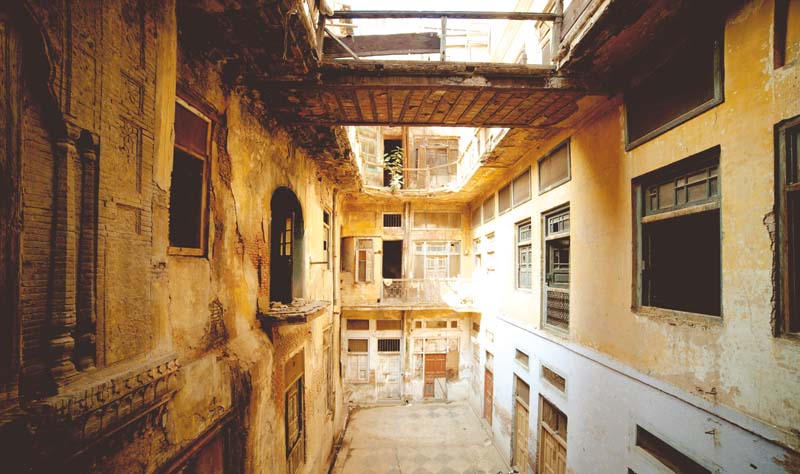
Entering the considerably vast roofed courtyard with small steps leading into the haveli, I noticed the splintered roof which still retains its original beauty. The walls were decorated majestically with carved balconies and jharokas, reminiscent of Sikh architecture. The entire building was built in brick, with some parts painted yellow. It seemed to be abandoned. I looked around for someone to give me more information and entered the main area, but there was not a single person in sight. The interior of the haveli was even more magical. It had a small square courtyard with rooms around it, some of which were locked.
 The ground floor of the haveli, currently being used by shoe-makers. PHOTO : NADEEM DAR
The ground floor of the haveli, currently being used by shoe-makers. PHOTO : NADEEM DARI was about to venture down a narrow corridor, when I heard someone warning me not to go ahead, saying it was haunted. Startled by the voice, I turned back, watching a dark, middle-aged man approach me. “What are you here for?” the man asked angrily. I figured that my camera and equipment probably upset him. I introduced myself to him, pacifying his reservations, and asked him if I could photograph the beautiful haveli and possibly meet its owner. He was the tenant of the haveli and said the owner was settled abroad.
The tenant, Ehsan, knew a lot about the haveli and its surroundings. According to him, it was built in the Sikh era by a dancer and prostitute, ‘Poori Bai,’ and was known as Poori Haveli. It was later renamed Noori Haveli or Noori Manzil. Before the Sikh era, the Red Light area was located inside Lohari Gate, and most of the affluent prostitutes had beautiful havelis there. Chowk Matti was also named after a known prostitute, ‘Matti Bai’. With the passage of time, the Red Light area was shifted to Chowk Jhanda, Tibbi Gali and, eventually, Heera Mandi was established.
 The brick-work and flowing lines seen on the walls of the haveli. PHOTO: NADEEM DAR
The brick-work and flowing lines seen on the walls of the haveli. PHOTO: NADEEM DARThe two-storey Noori Haveli has 32 rooms. It used to house dancing girls during the Sikh Era. There was even a stable for horses which has now been converted into shops. The rooms of the haveli have been rented out to shoe-makers at present. According to Ehsan, the occupied area of the haveli is 27 marlas. After 1947, the building was allotted to a local family which is still living in one of the sections.
I asked Ehsan if I could go to the top floor but he resisted for a while, mentioning the dilapidated state of the building and the risks involved. Eventually, we ascended the dark and narrow staircase despite his warnings about the portion being haunted. He maintained that anyone who tried going up the stairs got hit by an unknown force. A little apprehensive, I reached the first floor. Surviving the unseen force, I walked around what seemed like a doll house in shambles. The floor of the upper gallery was cracked and the railing was dusty. The walls were carved, and brick-work in a paisley design bordered everything. Logical, flowing lines, a specialty of Sikh architecture, are used to enhance the aesthetics of the building. The rooms were locked and the elevated gallery running around the courtyard exquisite — a living testament to the fact that this haveli was once surely a house of dancing girls. While photographing Noori Manzil, I was a little disheartened because of the apparent apathy in preserving it. Many of the historic houses or havelis inside the Walled City of Lahore have been commercialised now. The shoe-makers have already made their way into Noori Manzil, making me fear for its condition.
 The balconies or jharokha, reminiscent of Sikh architecture. PHOTO: NADEEM DAR
The balconies or jharokha, reminiscent of Sikh architecture. PHOTO: NADEEM DARNoori Manzil is a masterpiece of architecture and a beautiful gem hidden inside the Lohari Gate. Its residents are not financially sound enough to restore or maintain it; so, we can only hope it isn’t lost to the rapid commercialisation of old Lahore.
Nadeem Dar is a professional heritage photographer.
Published in The Express Tribune, Sunday Magazine, October 25th, 2015.

















COMMENTS (2)
Comments are moderated and generally will be posted if they are on-topic and not abusive.
For more information, please see our Comments FAQ